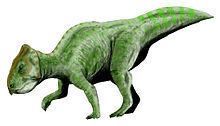Species †P. pieganensis Rank Genus | Class Reptilia Phylum Chordata | |
 | ||
Similar Cerasinops, Montanoceratops, Lamaceratops, Bainoceratops, Graciliceratops | ||
Prenoceratops, (meaning 'bent or prone-horned face' and derived from Greek prene-/πρηνη- meaning 'bent forwards' or 'prone', cerat-/κερατ- meaning 'horn' and -ops/ωψ meaning 'face') is a genus of ceratopsian dinosaur from the Late Cretaceous Period. Its fossils have been found in the upper Two Medicine Formation in the present-day U.S. state of Montana, in Campanian age rock layers that have been dated to 74.3 million years ago.
Contents
Discovery and species
Prenoceratops was first described by Brenda J. Chinnery in 2004. It is unusual in that it is the only basal neoceratopsian known from a bonebed.
Prenoceratops species include P. pieganensis (type).
Classification
Prenoceratops belonged to the Ceratopsia (which name is derived from Ancient Greek, meaning 'horned face'), a group of herbivorous dinosaurs with parrot-like beaks, which thrived in North America and Asia during the Cretaceous Period. It is closely related to Leptoceratops, which it antedates by several million years. It is characterized by a lower, more sloping head than that of Leptoceratops.
Diet
Prenoceratops, like all ceratopsians, was a herbivore. During the Cretaceous, flowering plants were "geographically limited on the landscape", and so it is likely that this dinosaur fed on the predominant plants of the era: ferns, cycads and conifers. It would have used its sharp ceratopsian beak to bite off the leaves or needles.
